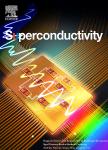Dominant effect of residual secondary phase of powders on Jc and microstructure of Bi-2212 superconducting wires
作者机构:Superconducting Materials Research CenterNorthwest Institute for Nonferrous Metal ResearchShaanxiXi’an 710016China
出 版 物:《Superconductivity》 (超导(英文))
年 卷 期:2023年第8卷第4期
页 面:1-8页
学科分类:08[工学] 080502[工学-材料学] 0805[工学-材料科学与工程(可授工学、理学学位)]
基 金:supported by the National Key R&D Program of China(2021YFB3800201) the National Science Fund Program of China(No.51777172,51902267) the Natural Science Basic Research Plan in Shaanxi Province(No.2022GY‐392,2021JQ‐884)
主 题:Superconductor Bi‐2212 wire Residual secondary phase Powder
摘 要:Bi_(2)Sr_(2)CaCu_(2)O_(8+δ)(Bi‐2212)superconducting round wires exhibited great potential for use in high‐field *** purity of the precursor powders is critical for the transport current of the ***,the role of the residual secondary phase in the precursor powders is not fully ***,the origin of the secondary phase was investigated in precursor powders that were prepared using ultrasonic spray pyrolysis(USP)and calcination *** microstructure and phase evolution of the precursor powders during the crystallization process were ***,the effects that the residual secondary phase has on melting behavior,morphology properties,and the supercurrent flow of Bi‐2212 multi‐filamentary wires are systematically *** residual secondary phase in the filament caused further crystallization,and this led to the formation of more and larger Bi‐2201 grains at the onset of the melting *** poor microstructure and low critical current of the final Bi‐2212 wires can be attributed to the presence of the residual copper‐rich ***‐2212 wires that were prepared with fully crystallized powders had a high critical current density(J_(c))of 6773 A/mm^(2) at 4.2 K,self‐*** was revealed that control of the secondary phases in precursor powders is greatly significant for achieving superior values of J_(c).



